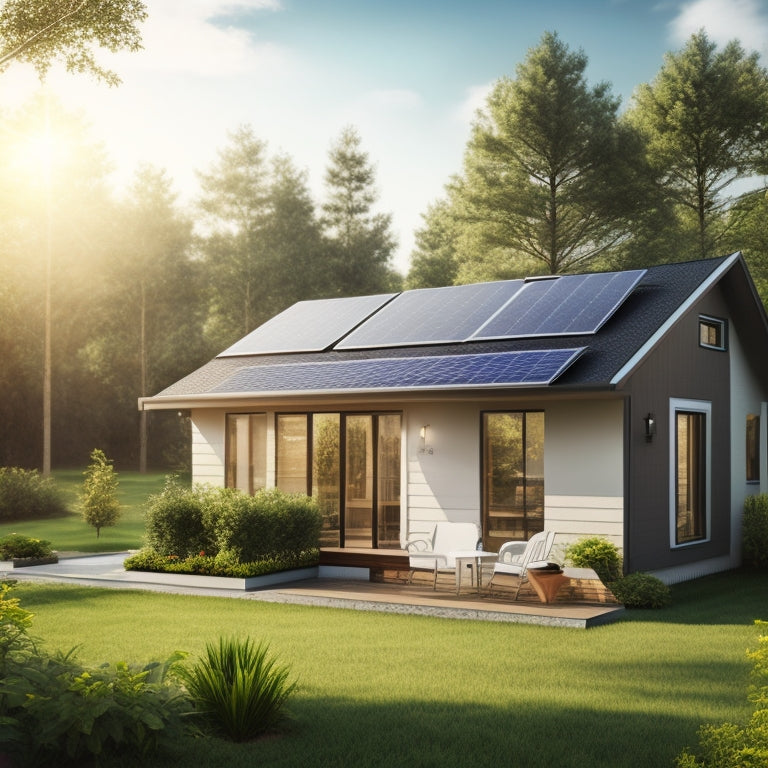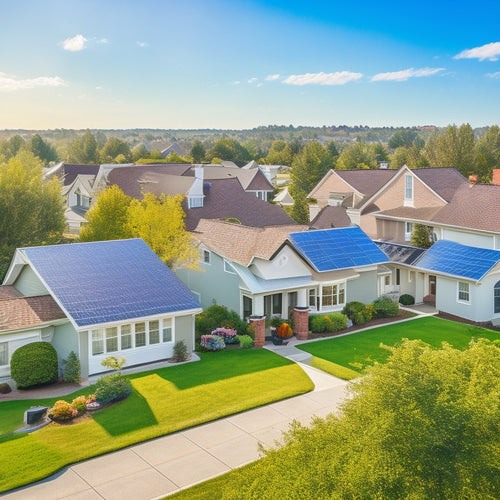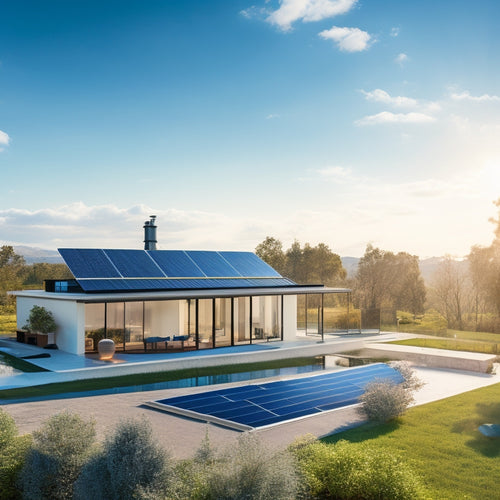
Small Home Solar Panel System Costs Explained
Share
You're looking to install a small home solar panel system, but want to know what it'll cost. On average, you'll pay $2.50 to $3.50 per watt, so a typical 5-kilowatt system would be around $15,000 to $25,000. The final cost depends on the system size, equipment, and installation labor costs. Roof size and layout also impact the total bill. The type of solar panels you choose affects energy output and efficiency. Additionally, you may want to contemplate a battery backup system, which adds to the overall cost. As you explore your options, you'll want to ponder these factors and more to get the best system for your home.
Key Takeaways
• The average cost of a small home solar panel system ranges from $15,000 to $25,000 for a 5-kilowatt system, or $2.50 to $3.50 per watt.
• The final cost depends on system size, equipment, and installation labor costs, which vary based on roof size, layout, and panel type.
• High-efficiency panels from reputable brands can cost up to $1.50 per watt, while budget-friendly options from Chinese manufacturers can cost around $0.80 per watt.
• Labor costs account for 10% to 20% of the total system cost, depending on complexity, local rates, and permitting requirements.
• Financial incentives like state tax credits, utility rebate programs, and local incentives can help reduce the overall cost of a small home solar panel system.
Average Cost of Solar Panels
When evaluating the cost of solar panels, it's crucial to grasp the financial aspects of this green investment. You're not just investing in a sustainable energy source; you're also contributing to the growing solar trends that are reshaping the energy landscape.
When calculating the cost of solar panels, you'll need to take into account the system's size, which directly affects the number of panels required. The quality of the equipment, including the panels and inverters, is another crucial factor.
Additionally, installation requirements, such as permits, inspections, and labor costs, will add to the overall expense. While the initial investment may seem substantial, remember that solar panels can significantly reduce your energy bills and increase your property value.
System Size and Cost Factors
You'll need to determine the ideal system size for your solar panel installation, as it directly impacts the overall cost, with larger systems requiring more panels and materials, thereby increasing expenses. A larger system may provide more power, but it also increases the cost of installation, maintenance, and repair. Conversely, a smaller system may be more affordable but mightn't provide enough power to meet your energy needs.
To optimize your system size, consider the following factors:
-
Energy Consumption: Assess your energy usage to determine the required system size. A larger system may be necessary if you have high energy demands.
-
Roof Space: Evaluate your available roof space to determine the maximum system size that can be installed.
-
Budget: Balance your energy needs with your budget constraints to determine the ideal system size for your installation.
Price of Solar Panel Equipment
Your solar panel system's overall cost is heavily influenced by the price of solar panel equipment, which can vary considerably depending on the quality, efficiency, and brand of components. High-efficiency panels from reputable brands like SunPower or Panasonic can cost up to $1.50 per watt, while budget-friendly options from Chinese manufacturers may be priced around $0.80 per watt.
When selecting solar panels, look for Solar Certifications like UL (Underwriters Laboratories) or IEC (International Electrotechnical Commission) marks, which guarantee compliance with industry standards. Additionally, consider Panel Warranties, which typically range from 25 to 30 years, and can offer peace of mind in case of equipment failure.
Be wary of extremely low prices, as they may indicate lower-quality components or reduced warranties. By balancing quality and cost, you can find the right solar panel equipment for your small home system.
Installation Costs and Labor
Installing a solar panel system necessitates a significant investment in labor costs, which can account for around 10% to 20% of the total system cost. You'll need to take into account the cost of hiring professionals to design, install, and connect your system to the grid. Labor costs can vary depending on factors such as the complexity of the installation, local labor rates, and permitting requirements.
Some key factors that can impact labor costs include:
-
Union labor: If you hire unionized labor, you can expect to pay a premium for their services.
-
Permitting requirements: The cost of obtaining necessary permits and meeting local building codes can add to your labor costs.
-
System design and installation complexity: More complex systems, such as those with multiple inverters or trackers, may require more labor hours and expertise, increasing costs.
Roof Size and Layout Impact
When considering a home solar panel system, you'll need to assess your roof's size and layout, as these factors can have a substantial impact on system performance and costs.
Your roof's orientation, for instance, can affect the amount of sunlight your panels receive, while shading from trees or other obstacles can reduce energy output.
Roof Orientation Matters
The size and layout of your roof greatly impact the number of solar panels that can be installed, as well as their overall efficiency. When it comes to maximizing your solar panel system's performance, roof orientation matters.
To optimize energy production, you'll want to take into account the following factors:
-
Solar Direction: Ideally, your roof should face south, as this orientation receives the most direct sunlight throughout the day. East- and west-facing roofs can also work well, but north-facing roofs aren't ideal.
-
Roof Angles: The angle of your roof also affects energy production. A tilt between 30° and 40° is ideal, as it allows for efficient energy capture.
-
Obstructions: Be mindful of obstructions like skylights, vents, and chimneys, which can reduce the available space for solar panels and impact system performance.
Shading Affects Performance
Shading from trees, buildings, or other obstructions can drastically reduce your solar panel system's energy production, making it essential to assess your roof's layout and size to identify potential shading issues. As you consider installing a solar panel system, you'll want to evaluate your roof's exposure to shading from surrounding structures or natural obstructions.
Tree shadows, for instance, can cast a significant shadow on your roof, reducing energy output. Similarly, building overhangs or neighboring structures can also block sunlight from reaching your solar panels.
To mitigate these effects, you'll need to assess the shading patterns on your roof. You can do this by observing the movement of shadows throughout the day or using specialized software to simulate shading patterns. By understanding the shading patterns on your roof, you can strategically position your solar panels to maximize energy production.
This may involve installing panels in a way that minimizes shading or using specialized panel designs that can better handle shading. By taking shading into account, you can optimize your solar panel system's performance and maximize your energy output.
Obstacles Increase Costs
Obstacles on your roof, including vents, skylights, and chimneys, will increase the cost of your solar panel system by requiring more complex installations and specialized equipment. These obstacles can lead to additional labor costs, as installers need to work around these features, which can be time-consuming and require more materials.
Additionally, you may encounter external obstacles that can drive up costs, including:
-
Permitting delays: Delays in obtaining necessary permits can slow down the installation process, leading to increased costs.
-
Zoning issues and building codes: Compliance with local zoning laws and building codes can require additional modifications to your system, adding to the overall cost.
-
Neighborhood objections and material shortages: Supply chain disruptions or neighborhood objections can further complicate the installation process, leading to increased costs.
It's crucial to take into account these potential obstacles when planning your solar panel system installation for a smooth and cost-effective process.
Local Incentives and Rebates
When considering the cost of a home solar panel system, you'll want to explore local incentives and rebates that can help offset the upfront investment.
You may be eligible for state tax credits, which can greatly reduce your taxable income. Additionally, utility rebate programs may offer cash incentives for installing solar panels, so it's important to research and understand what's available in your area.
State Tax Credits
You can claim state tax credits, which vary by location, to offset your state income tax liability and reduce the upfront cost of your solar panel system. These credits can have a substantial impact on the overall cost of your solar panel installation, making it more affordable.
To take advantage of state tax credits, you'll need to make sure you meet the credit eligibility requirements. Here are some key considerations:
-
Tax exemptions: Some states exempt a portion of your solar panel system's value from your property taxes, reducing your annual tax bill.
-
Credit carryover: If you can't claim the full credit in one year, some states allow you to carry over the excess credit to future years.
-
Credit transferability: In some states, you can transfer or sell your tax credits to other entities, providing additional financial flexibility.
Remember to research your state's specific tax credit policies and eligibility requirements to maximize your savings.
Utility Rebate Programs
In addition to state tax credits, you can also take advantage of utility rebate programs, which offer local incentives and rebates to further reduce the cost of your solar panel system. These programs are offered by your local utility company and can provide a one-time rebate based on the size of your solar panel system.
To be eligible for these rebates, you'll need to meet the program rules, which typically include requirements such as system size, installation date, and equipment certification.
Rebate eligibility varies by utility company, so it's crucial to check with your provider to see what's available. Some utilities offer a fixed rebate amount per watt of installed solar capacity, while others provide a percentage of the total system cost.
Be sure to review the program rules carefully to make certain you meet the requirements and can receive the rebate. By combining state tax credits with utility rebate programs, you can significantly reduce the upfront cost of your solar panel system and start generating clean energy sooner.
Type of Solar Panels Used
The type of solar panels used can greatly impact the overall cost of your home solar panel system, as different panel types vary in efficiency, durability, and price point. As you evaluate your options, it's crucial to comprehend the characteristics of each type in order to make an informed decision.
When it comes to panel efficiency, you'll want to seek out high-efficiency panels that can generate more power per hour of sunlight. This is particularly important if you have limited roof space. Here are some key factors to take into account:
-
Monocrystalline Silicon (mono-Si) cells: These cells are more efficient but also more expensive. They're ideal for small roofs or regions with limited sunlight.
-
Polycrystalline Silicon (poly-Si) cells: These cells offer a balance between efficiency and cost. They're a popular choice for residential solar systems.
-
Thin-Film Solar Cells: These cells are less efficient but cheaper. They're suitable for large roofs or areas with abundant sunlight.
Energy Efficiency and Output
Your solar panel system's energy efficiency and output are closely tied to the type of panels you choose, and understanding the differences in their electrical characteristics is essential to optimizing your system's performance.
When it comes to energy harvesting, the right panels can make all the difference. Peak performance is achieved when your system is operating at its maximum capacity, and this is largely dependent on the panel's ability to convert sunlight into electricity.
Efficiency ratings, usually expressed as a percentage, indicate how well a panel converts sunlight into electricity. Higher efficiency ratings translate to more power per unit area, making them ideal for smaller roofs or spaces. However, higher-efficiency panels often come at a higher cost.
On the other hand, lower-efficiency panels may be more budget-friendly but may require more space to generate the same amount of power.
When selecting panels, consider your energy needs, available space, and budget. By balancing these factors, you can maximize your energy harvesting capabilities and achieve peak performance from your solar panel system.
Battery Backup System Costs
As you consider adding a battery backup system to your home solar panel setup, you'll need to think about system sizing and backup power capacity.
You'll want to determine how much backup power you need to cover your essential appliances during an outage, and then size your battery bank accordingly.
System Sizing Considerations
Determining the ideal system size for your battery backup system requires careful consideration of your energy needs and usage patterns. You'll want to guarantee that your system can meet your energy demands during power outages, while also optimizing energy efficiency.
A load calculation is essential to determine the total wattage requirement of your essential appliances and devices.
To accurately size your system, consider the following factors:
-
Energy efficiency: Assess your energy usage patterns to identify areas for improvement, allowing you to optimize your system's performance.
-
Load calculation: Calculate the total wattage requirement of your essential appliances and devices to determine the required battery capacity.
-
Usage patterns: Analyze your daily energy usage patterns to determine the required backup power capacity during extended outages.
Backup Power Capacity
A battery backup system's power capacity, measured in watt-hours (Wh), directly impacts its cost, with a higher capacity system typically resulting in a higher upfront investment.
As you consider your energy needs, think about how much power you'll require during an outage. If you want to keep your fridge running, you'll need a system with a higher capacity.
For off-grid systems, a larger battery bank is often necessary to provide emergency power during extended periods of low sunlight. In these cases, a higher-capacity system can be a worthwhile investment.
However, if you're looking for a system to provide backup power during short outages, a smaller capacity system might suffice.
When sizing your battery backup system, consider your essential loads, such as lights, refrigerator, and medical equipment. Calculate your total watt-hours required during an outage, and choose a system that can meet that demand.
Keep in mind that a higher-capacity system will generally increase the overall cost, but it will also provide you with more power and peace of mind during an emergency.
Maintenance and Repair Fees
You can expect to pay around $100 to $300 per year for routine maintenance and repair fees to guarantee your home solar panel system operates efficiently. This cost is a small price to pay for the benefits of renewable energy and reduced utility bills. Regular maintenance guarantees your system runs at peak levels, maximizing your energy production and savings.
Some factors to take into account when it comes to maintenance and repair fees include:
-
Scheduling Challenges: Coordinating maintenance schedules with your installer or a third-party provider can be time-consuming and may require some flexibility.
-
Warranty Options: Review your warranty carefully to understand what's covered and what's not, as this can impact your maintenance and repair costs.
-
Component Replacement: Over time, components may need to be replaced, such as inverters or panels, which can add to your maintenance and repair fees.
Frequently Asked Questions
Can I Install Solar Panels on a Metal or Tile Roof?
When installing solar panels on a metal or tile roof, you'll encounter unique challenges. You'll need to take into account the roof material's weight capacity, ensuring it can support the panels' weight without compromising structural integrity, especially on complex roof shapes.
How Long Does It Take to Install a Small Home Solar System?
You'll typically spend 2-5 days waiting for permits, and 1-3 days for installation, depending on your roof's complexity. Labor costs account for 10-20% of total costs, with the installation timeline affecting your overall expenses.
Are Solar Panels Resistant to Extreme Weather Conditions?
You'll be relieved to know that solar panels are designed to withstand extreme weather conditions, boasting impressive weather durability and storm resistance, ensuring your power supply remains uninterrupted even in harsh climates.
Can I Add More Panels to My System in the Future?
"Ha! You think you'll outgrow your solar panel system? Think again! You can easily expand your system in the future, adding more panels as your energy needs grow, making system expansion and future upgrades a breeze."
Do Solar Panels Generate Power During a Power Outage?
During a power outage, you won't generate power with standard grid-tied solar panels, as they prioritize grid reliability. However, you can explore backup options like battery storage systems to guarantee continuous energy supply.
Related Posts
-

What Does Residential Solar Panel Installation Cost?
You're looking to Install residential solar panels, but you're wondering what it'll set you back. On average, you can...
-

Sustainable Commuting: Top Daily Use Electric Bicycles
You're looking to trade in your gas-guzzling vehicle for a more sustainable option, and a daily use electric bicycle ...
-

Why Opt for High-Efficiency Solar Panels Online?
You can greatly enhance your solar energy output and savings by upgrading to high-efficiency solar panels, which can ...


